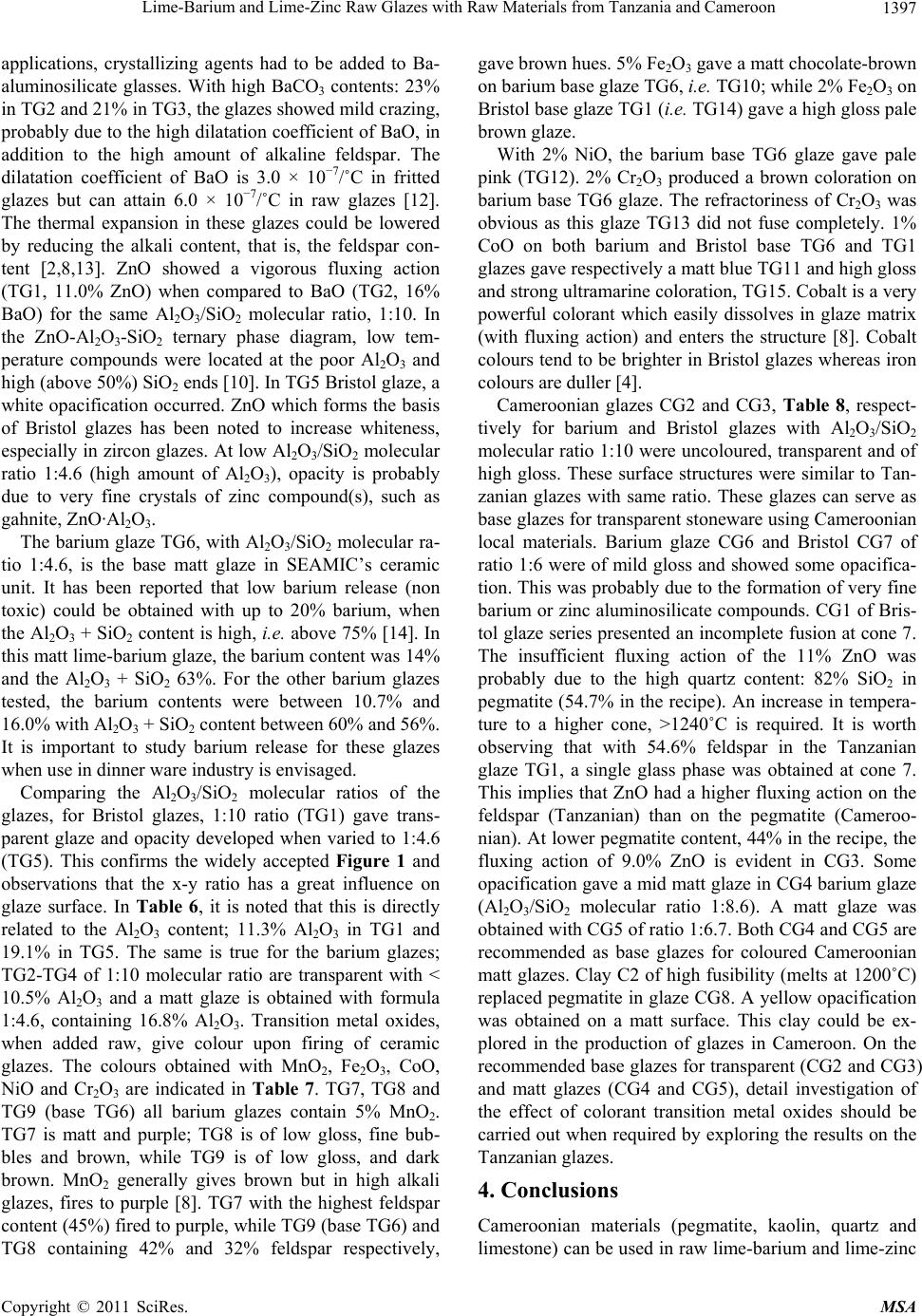
Lime-Barium and Lime-Zinc Raw Glazes with Raw Materials from Tanzania and Cameroon1397
applications, crystallizing agents had to be added to Ba-
aluminosilicate glasses. With high BaCO3 contents: 23%
in TG2 and 21% in TG3, the glazes showed mild crazing,
probably due to the high dilatation coefficient of BaO, in
addition to the high amount of alkaline feldspar. The
dilatation coefficient of BaO is 3.0 × 10−7/˚C in fritted
glazes but can attain 6.0 × 10−7/˚C in raw glazes [12].
The thermal expansion in these glazes could be lowered
by reducing the alkali content, that is, the feldspar con-
tent [2,8,13]. ZnO showed a vigorous fluxing action
(TG1, 11.0% ZnO) when compared to BaO (TG2, 16%
BaO) for the same Al2O3/SiO2 molecular ratio, 1:10. In
the ZnO-Al2O3-SiO2 ternary phase diagram, low tem-
perature compounds were located at the poor Al2O3 and
high (above 50%) SiO2 ends [10]. In TG5 Bristol glaze, a
white opacification occurred. ZnO which forms the basis
of Bristol glazes has been noted to increase whiteness,
especially in zircon glazes. At low Al2O3/SiO2 molecular
ratio 1:4.6 (high amount of Al2O3), opacity is probably
due to very fine crystals of zinc compound(s), such as
gahnite, ZnO·Al2O3.
The barium glaze TG6, with Al2O3/SiO2 molecular ra-
tio 1:4.6, is the base matt glaze in SEAMIC’s ceramic
unit. It has been reported that low barium release (non
toxic) could be obtained with up to 20% barium, when
the Al2O3 + SiO2 content is high, i.e. above 75% [14]. In
this matt lime-barium glaze, the barium content was 14%
and the Al2O3 + SiO2 63%. For the other barium glazes
tested, the barium contents were between 10.7% and
16.0% with Al2O3 + SiO2 content between 60% and 56%.
It is important to study barium release for these glazes
when use in dinner ware industry is envisaged.
Comparing the Al2O3/SiO2 molecular ratios of the
glazes, for Bristol glazes, 1:10 ratio (TG1) gave trans-
parent glaze and opacity developed when varied to 1:4.6
(TG5). This confirms the widely accepted Figure 1 and
observations that the x-y ratio has a great influence on
glaze surface. In Table 6, it is noted that this is directly
related to the Al2O3 content; 11.3% Al2O3 in TG1 and
19.1% in TG5. The same is true for the barium glazes;
TG2-TG4 of 1:10 molecular ratio are transparent with <
10.5% Al2O3 and a matt glaze is obtained with formula
1:4.6, containing 16.8% Al2O3. Transition metal oxides,
when added raw, give colour upon firing of ceramic
glazes. The colours obtained with MnO2, Fe2O3, CoO,
NiO and Cr2O3 are indicated in Table 7. TG7, TG8 and
TG9 (base TG6) all barium glazes contain 5% MnO2.
TG7 is matt and purple; TG8 is of low gloss, fine bub-
bles and brown, while TG9 is of low gloss, and dark
brown. MnO2 generally gives brown but in high alkali
glazes, fires to purple [8]. TG7 with the highest feldspar
content (45%) fired to purple, while TG9 (base TG6) and
TG8 containing 42% and 32% feldspar respectively,
gave brown hues. 5% Fe2O3 gave a matt chocolate-brown
on barium base glaze TG6, i.e. TG10; while 2% Fe2O3 on
Bristol base glaze TG1 (i.e. TG14) gave a high gloss pale
brown glaze.
With 2% NiO, the barium base TG6 glaze gave pale
pink (TG12). 2% Cr2O3 produced a brown coloration on
barium base TG6 glaze. The refractoriness of Cr2O3 was
obvious as this glaze TG13 did not fuse completely. 1%
CoO on both barium and Bristol base TG6 and TG1
glazes gave respectively a matt blue TG11 and high gloss
and strong ultramarine coloration, TG15. Cobalt is a very
powerful colorant which easily dissolves in glaze matrix
(with fluxing action) and enters the structure [8]. Cobalt
colours tend to be brighter in Bristol glazes whereas iron
colours are duller [4].
Cameroonian glazes CG2 and CG3, Table 8, respect-
tively for barium and Bristol glazes with Al2O3/SiO2
molecular ratio 1:10 were uncoloured, transparent and of
high gloss. These surface structures were similar to Tan-
zanian glazes with same ratio. These glazes can serve as
base glazes for transparent stoneware using Cameroonian
local materials. Barium glaze CG6 and Bristol CG7 of
ratio 1:6 were of mild gloss and showed some opacifica-
tion. This was probably due to the formation of very fine
barium or zinc aluminosilicate compounds. CG1 of Bris-
tol glaze series presented an incomplete fusion at cone 7.
The insufficient fluxing action of the 11% ZnO was
probably due to the high quartz content: 82% SiO2 in
pegmatite (54.7% in the recipe). An increase in tempera-
ture to a higher cone, >1240˚C is required. It is worth
observing that with 54.6% feldspar in the Tanzanian
glaze TG1, a single glass phase was obtained at cone 7.
This implies that ZnO had a higher fluxing action on the
feldspar (Tanzanian) than on the pegmatite (Cameroo-
nian). At lower pegmatite content, 44% in the recipe, the
fluxing action of 9.0% ZnO is evident in CG3. Some
opacification gave a mid matt glaze in CG4 barium glaze
(Al2O3/SiO2 molecular ratio 1:8.6). A matt glaze was
obtained with CG5 of ratio 1:6.7. Both CG4 and CG5 are
recommended as base glazes for coloured Cameroonian
matt glazes. Clay C2 of high fusibility (melts at 1200˚C)
replaced pegmatite in glaze CG8. A yellow opacification
was obtained on a matt surface. This clay could be ex-
plored in the production of glazes in Cameroon. On the
recommended base glazes for transparent (CG2 and CG3)
and matt glazes (CG4 and CG5), detail investigation of
the effect of colorant transition metal oxides should be
carried out when required by exploring the results on the
Tanzanian glazes.
4. Conclusions
Cameroonian materials (pegmatite, kaolin, quartz and
limestone) can be used in raw lime-barium and lime-zinc
Copyright © 2011 SciRes. MSA